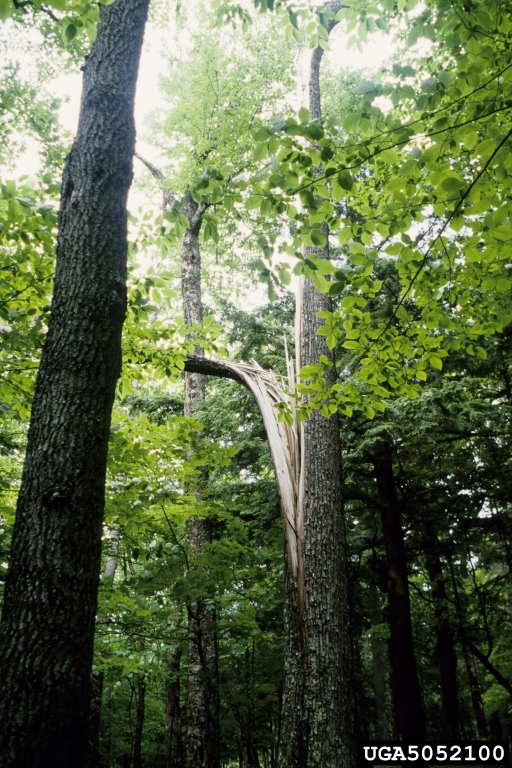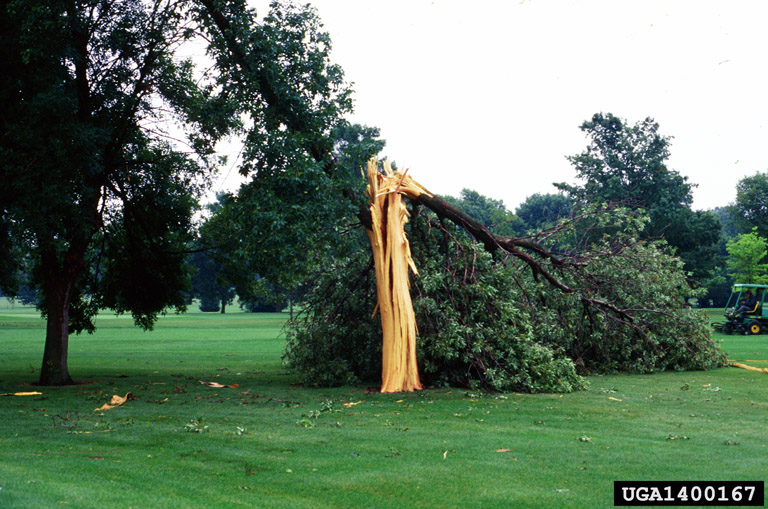Spring and summer storms take their toll on landscape plants. Branches may be broken by wind and whole trees uprooted. Lightning strikes to trees can be both spectacular and deadly, though the two don’t necessarily go together. The effects of lightning strikes on trees are highly variable. Management of a damaged tree should be based on several factors.
Lightning occurs when long downward chains of negatively charged particles at the base of storm clouds meet vertical streamers of positively charged ions coming up from the ground.

How Does Lightning Damage a Tree?
Lightning, like electricity, follows the path of least resistance. While wood isn’t a great conductor, water and sap inside a tree increase its conductivity, as does water on the bark from rain. Plus, trees are often the tallest component of a landscape – making them natural lightning rods – and prone to developing streamers of positively charged ions which make up one half of a lightning strike. Solitary trees in an open space, trees on top of a hill or the tallest tree in an area are prone to lightning strikes.
The extent of lightning damage can vary widely. During a storm, lightning can strike a tree once or multiple times. It can travel down one branch or set of branches, or through the entire tree from top to roots. It can skip from the top of the tree down to the roots. It can pass shallowly over wet bark, down through the phloem or through the deeper inner wood which transports water. How the lightning moves and how deeply it penetrates the tree will determine the extent of damage.
With up to 100 million volts and a temperature of up to 50,000 degrees F, lightning causes water and sap in a tree to boil and steam, blowing off the bark or causing wood fiber to explode.
Common signs of a lightning strike include the following.
- An array of bark damage from a narrow strip blown off the trunk, all the way to a completely debarked tree.
- Deep vertical cracks in the branches or trunk.
- Severely split branches or trunk.
- Invisible interior damage from superheated electrical discharge in the trunk or roots.
Assessing a Lightning-Struck Tree
Unless the tree has severely cracked or split branches/trunk, or broken hanging branches in the canopy, taking a wait-and-see attitude is recommended to determine if the tree can recover. A lightning-struck tree, even one with little apparent damage, may not survive – only time will tell. Waiting a few months to see what happens is necessary.

While assessing the tree, consider 1) the extent of damage, 2) the tree species and 3) rate the tree’s function and health prior to the storm. A large, healthy tree of a desirable species that was growing well, and contributing to the appearance of the landscape and the value of the property is one thing; a large, partly rotten box elder that’s threatening to fall on the garage is something else entirely. One is an asset to the property; the other is a threat. Add damage from a lightning strike, and the boxelder becomes even less desirable.
Consider these guidelines while assessing.
- Split trunk – tree’s trunk is partially or totally split apart. The structural integrity of this tree is lost and inevitable future wood rot decay will cause it to deteriorate further. Remove tree.
- Deep crack(s) on main trunk – vertical cracks with a depth of 1/3 or more of tree’s diameter. Significant damage to inner wood, structural defects likely, future wood rot inevitable. Remove tree if it is near high-value targets, such the home, garage, driveway, busy streets, ect.
- Deep crack(s) on main branches – cracks with a depth of 1/3 or more branches diameter. Branch removal or shortening recommended to lighten weight on the branch.
- Canopy damage – if more than 1/3 of canopy is lost, consider removing the tree.
- Bark damage/loss
- Less than 1/3 tree’s circumference – narrow strips of bark blown off tree. Monitor tree for signs of internal damage and prevent drought stress as it recovers.
- More than 1/3 tree’s circumference – tree’s ability to move water during dry periods, opportunistic pest attack and future wood rot are serious concerns. Remove tree, unless it is a very high-value species, especially if there are high-value targets nearby.
Managing Damaged Trees
If you decide to keep a damaged tree, use a sharp utility knife to trim off any loose bark back to healthy tissue so it can heal. If it’s safe to do so, prune off any broken branches or hire an arborist to complete the work. Water the tree when conditions are dry to prevent compounding the tree’s problems with drought stress, then cross your fingers and wait.
Or, if bark is still attached and the underside (growing cells) are still moist, tack the bark in place with nails and cover the damaged area with burlap or plastic for several months to aid the bark in reattachment.
Preventative pesticide applications can protect the tree from opportunistic pests, including many species of native borers, while it recovers.
Sometimes lightning-struck trees literally explode, with much shattering of bark and splintering of wood. Other trees may show few, if any, signs of damage but die later from root injury. Some trees may die immediately; others may survive what looks like terrible damage and continue to grow.
A tree that is reduced to a pile of splintered wood is obviously no candidate for repairs and should be removed. Because the long-term survival of a lightning-struck tree isn’t certain, spending time or effort to salvage a seriously damaged tree isn’t worth it. That time and effort might be better spent replacing the damaged tree.
More information: Caring for Lightning-Struck Trees, Alabama A&M & Auburn University

Leave a comment